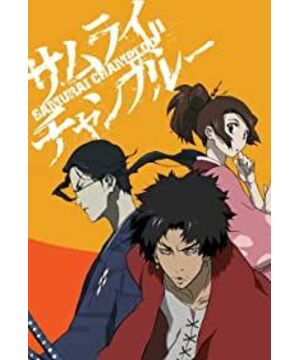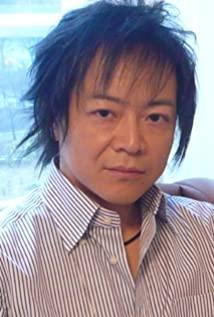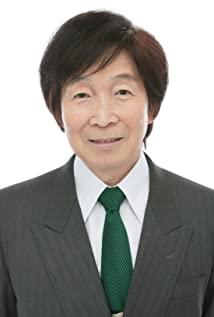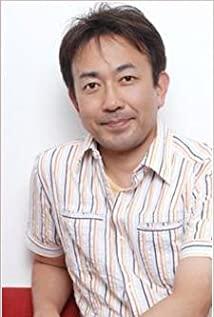また夜が明ければおDon't れ.
What attracted me was the cute girl on the cover, the famous Chaos Warrior.
What makes me stay is the unique editing style, the wonderful narrative, and the intense characterization.
The journey was finally over, and the author felt lost and helpless, so I wrote this article to console myself.
About the title
Let's take a look at the original title first: Sumurai Champloo.
First of all, Sumurai means samurai, of course, but this Champloo annoys me because I didn't find its explanation in the dictionary. Finally, the author learned that Champloo ( チャンプル ) is a kind of Okinawan dish that stir-fries vegetables and tofu together, and in the Okinawan dialect, it also means "mixed together", which can be called "Samurai Chowder" in paraphrase.
Let's take a look at the translation: Chaos Warrior.
The author likes this translation the most among the translations. Because the original title has a meaning of "mixing up samurai", and it uses Champloo (チャンプル), which is very familiar to Japanese, as a metaphor, two familiar words colliding together probably have a wonderful feeling. So how can we translate this feeling and minimize the semantic loss? "Chaos Warrior" is a good answer. First of all, the word "chaos" is not a rare word in the Chinese system, but it has some cultural loads, and "chaos" can give people a feeling of "mixed together" and "chaotic", and its metaphor and semantics have been well supported. Nice reservation.
About the soundtrack and editing
The soundtrack and editing are definitely a highlight of this work. Japanese music, jazz-hiphop, rap are combined with multi-line narrative, eye-catching transitions and montages, just like the title of "Champloo ( チャンプル )" , like an unforgettable hodgepodge.
The supervisor is very clear about how to edit and how to make the soundtrack so that the picture can be deeply embedded in the audience's mind, so as to achieve the purpose of shaping the characters, revealing the characters' characters, advancing the plot, and developing the narrative. Ren in the rain pulled his beloved out of the brothel, immersed in the water and recalled his life without illusion, the wind running in his dreams, the gangster who poured his enthusiasm into graffiti on the street, and the parting of the last three. The reason why these pictures are so successful is naturally due to the soundtrack and editing.
The excellent editing of this work also makes the suspense design of each story more natural. For example, in the last three episodes, the battle between Zhongren and the "Sword God", leaving only the blood and two shadows in the air, cuts to the picture without illusion, which undoubtedly gives the audience room for imagination, and after the camera is pulled back, it can be Use the audience's imagination to mobilize their feelings, so that they have a sense of consistency or a sense of gap, to achieve the effect of polishing the story.
Equally excellent is the battle scene of this work, which is naturally inseparable from the appropriate soundtrack and editing. Through the battles of different styles, the characters and emotions of anger, rationality, sinisterness, recklessness, etc. are depicted. At the same time, the combination of sound and picture gives people a sense of stimulation.
About "The Samurai of the Sunflower Scent"
"Sunflower-smelling samurai" is a very important clue and image in this work. It is the goal, the reason, the MacGuffin of this work.
When the author first started watching it, I thought of an ending: it is nothing, it is just an excuse made up by a lonely wind from beginning to end; or there is such a thing, but it cannot be found. In fact, it doesn't have to be "sunflower-smelling warrior", it can be "catnip-scented songstress" or something else, just like Godot in "Waiting for Godot", a symbol of fate and hope.
Of course, in the end, this idea of the author did not come true. It does exist, and it is the thread that connects all events, the direction and destination of the threesome. And this actually contains some philosophical thinking: after finding it? Everyone goes through events in their life, setting goals for themselves, fantasizing that after "that" everything will be alright, or like the wind hoping that "the end" will never come. However, both fantasies are unrealistic. After Feng found his father, nothing happened, and he didn't "beat him hard", and the "end" came after all, and the three eventually parted ways. Life is the sum of countless processes. When one process ends, another process begins, just as the three of them embark on their own journeys with their own beliefs at the end. There is no process that will not end, because there is no lasting feast in the world. But "the end" doesn't mean anything, it's just the beginning of another process. To the end of death.
How to tell a story in 20 minutes
Another outstanding feature of this work is that it not only retains the structural integrity of the entire story, but also preserves the relative independence of each story. This kind of structure called "unit drama" is not uncommon in fan dramas, "The Big Bang Theory", "Detective Conan", "Assassin Wu Liuqi" are all good examples. But the unit play of this work really surprised the author.
Yes, stunning. That's the only way I can describe my feelings. The story of this work has three scales: short, medium and long, corresponding to the stories of one episode, two levels and three episodes respectively. Even long stories are about an hour long, and short stories are only twenty minutes. And every story is that the sparrow is small, but it has all the internal organs. It can be said that you can see a miniature life in each different story.
And how does this work do that? As you can see, the clever use of turns and rhythm changes is the key. Taking episode 11 as an example, Jen's mentality changed many times, and the plot (story arc) changed several times, from his decision to go to a brothel to his desire to take her, to his letting her on board and then staying on his own. These turnings are not only not abrupt, but also in line with the characters' characters, but they are inconsistent with the audience's expectations, which gives people a great sense of impact, and the whole story is covered with a layer of mist, which makes people continue to reminisce. The change in rhythm is also reflected in the change of narrative style from gag to tragic, which makes the characters' stories very impactful.
The arrangement of stories is also very interesting, often in the way of comedy, tragedy and comedy, which also effectively avoids the audience's aesthetic fatigue for similar stories.
About Sancha Road
"また夜が明ければお Farewell れ (we will leave at dawn)."
This is the first sentence in the ED, and one that runs through the entire work. This work is actually a work about parting, and the fork in the road is an image that recurs in the work. Feng, Ren and Wuhuan have been separated and reunited many times, until the last three set foot on the fork in the road again and parted ways.
After reading this work, the author believes that separation is the normal state of life, and encounter is the accident of life. Everyone doesn't need to worry too much about the inevitable separation, just like the three at the end, just be calm about it. After all, separation is not a goodbye, and we will meet again if we are destined. The author also believes that the three of them will meet again one day, just like three particles moving randomly in a chaotic system, just like the Champloo ( チャンプル ) mixed together. As the wind said:
"またいつか. (We will definitely meet again.)"
rooster + fish + flower
Let's take a look at our three protagonists again.
Rooster, no illusion. He is reckless, impulsive, likes girls with big breasts, is not afraid of death, saves face in death, uses his anger and does not like to use his brain, but he can keep calm in the face of major events and make choices that he will not regret. Born in Ryukyu, he has many enemies, but he is never afraid.
fish, benevolence. He is calm, rational, taciturn, and restrained. He often doesn't say anything directly. He also uses his brain to think during battle. He has his own principles and is polite, but he behaves childishly and willfully in front of his friends. Those who love will also boldly show their love and try their best to help. He was framed by someone to carry the name of killing a master, but he did not argue, but silently carried the charge and started the journey for some unknown reason.
flowers, wind. She is kind, cheerful, very eatable and sometimes fat and thin, she likes bickering with Wuhuan, has a strong sense of justice, and is sentimental, but she is prone to cry when she is moved by her true feelings. She has been searching for her father, but can't do anything when she finds it.
Roosters, fish and flowers are just like Champloo ( チャンプル ) mixed together for no apparent reason, but they collide with countless stories. At first I thought Feng liked Ren, but later I thought Feng liked Wuhuan. But in the end, when they parted ways, I found that it was too simple to use love to measure their friendship. Feng was actually afraid of loneliness, so she felt so uncomfortable every time they separated, but her feelings for the two It is by no means a simple love, but a mixture of many emotions such as trust, dependence, disgust, and wanting to possess. In fact, this is the case between the three of them, just as Ren He Wuhuan was relieved at the last moment: "I don't want to kill you now."
Rooster + Fish + Flower = Sumurai Champloo.
View more about Samurai Champloo reviews











